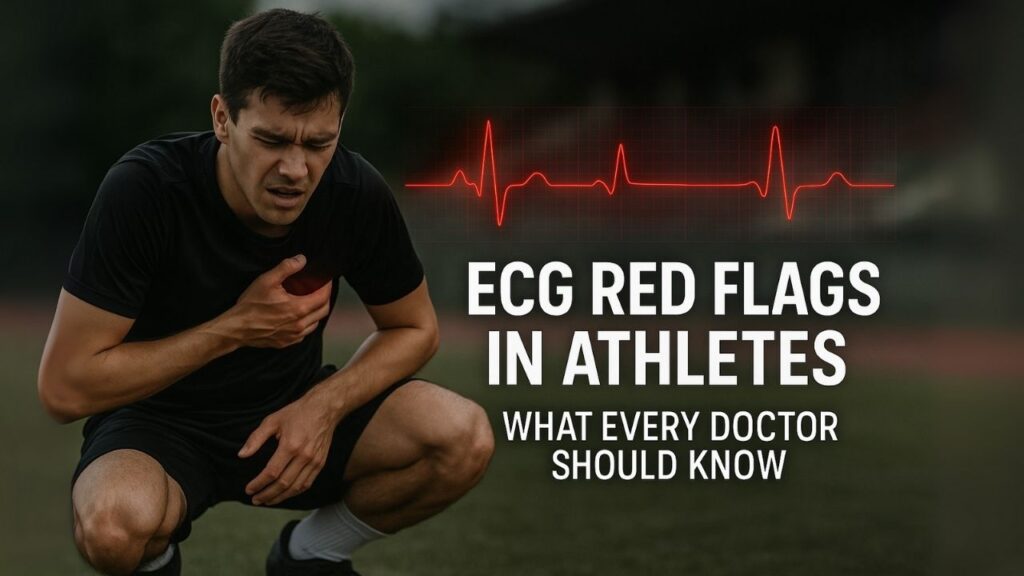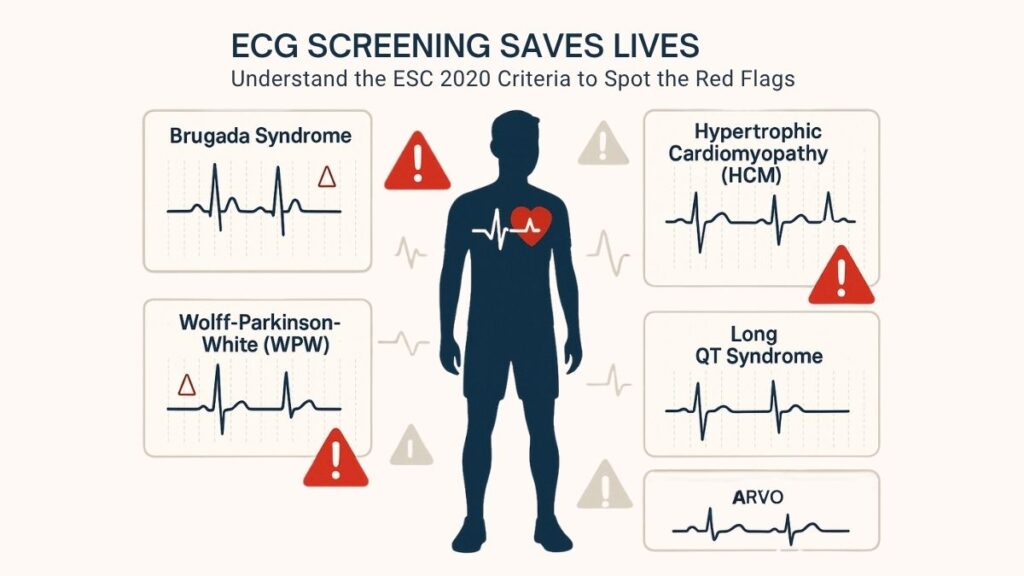public_health_notice
Athlete ECG: Predicting Sudden Death in Sports : ESC ECG Criteria (updated)
From Brugada pattern to hypertrophic cardiomyopathy signs—here’s what expert cardiologists examine on ECGs to prevent sudden cardiac death in athletes. Latest ESC and AHA guidelines included.
By Dr. Raj K | Published on July 6, 2025

🏥 ECG Red Flags That Predict Sudden Death in Athletes
⚡ Why It Matters
Sudden cardiac death (SCD) in athletes, though rare, is often preventable. Most cases are due to silent heart diseases detectable by a simple ECG—if read correctly. With pre-participation screening becoming more common globally, understanding which ECG patterns are truly dangerous can save lives.
📋 What Cardiologists Look For in Athlete ECGs
The European Society of Cardiology (ESC) and American Heart Association (AHA) recommend ECG screening for young athletes, particularly in competitive sports. Here are the top ECG abnormalities linked to risk:

1. Brugada Pattern
- What it looks like: Coved ST-segment elevation in V1–V3.
- Risk: Linked to ventricular arrhythmias and sudden death during rest or sleep.
2. Hypertrophic Cardiomyopathy (HCM)
- ECG signs: Deep Q waves in lateral leads, left atrial enlargement, left axis deviation.
- Note: HCM is the most common cause of SCD in athletes under 35.
3. Wolff-Parkinson-White Syndrome (WPW)
- ECG signs: Short PR interval, delta wave.
- Risk: Rapid conduction can lead to atrial fibrillation and VF.
4. Long QT Syndrome
- ECG signs: QTc >470ms (males) or >480ms (females).
- Danger: Can lead to torsades de pointes during exertion.
5. Arrhythmogenic Right Ventricular Cardiomyopathy (ARVC)
- ECG signs: Epsilon wave in V1, T-wave inversion in V1–V3.
- Prevalence: A leading cause of SCD in athletes in Italy and parts of Europe.
🧭 Normal vs. Abnormal: Athlete’s Heart or Hidden Danger?
Athletes often have ECG changes due to training—like sinus bradycardia, early repolarization, or isolated QRS voltage criteria for LVH. The key is distinguishing physiological adaptations from pathological red flags.
🔎 ESC 2020 Criteria Highlights:
- Normal variants: Incomplete RBBB, sinus bradycardia, early repolarization.
- Abnormal variants: T-wave inversions (V2–V6), ST depression, pathologic Q waves, prolonged QT.
🏁 Conclusion: Screening Saves Lives—but Requires Skill
Pre-participation ECG screening can reduce the incidence of sudden death in athletes by up to 89% when done with proper criteria and follow-up. The future lies in training more physicians to interpret athlete ECGs accurately—using tools like the Seattle Criteria and the International Consensus.
Caramoci A, Smaranda AM, Drăgoiu TS, Bădărău IA. ECG Screening in Athletes: A Systematic Review of Sport, Age, and Gender Variations. Rev Cardiovasc Med. 2025 May 28;26(5):38209. doi: 10.31083/RCM38209. PMID: 40475715; PMCID: PMC12135641.
Related ECG News
-
Wearable ECG Tech Spots Post-Surgery Heart Risks: Vivalink & Brigham Study Paves The Way For Safer Recoveries
July 15, 2025 -
NIT‑Rourkela’s New Atrial Lead System Enhances ECG Clarity for Arrhythmia Detection
July 13, 2025 -
AI-Enhanced ECG May Help Detect Cognitive Decline Years Before Symptoms Appear, AHA Study Finds
July 13, 2025